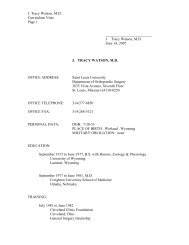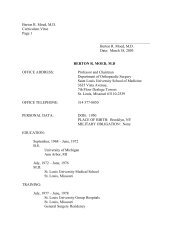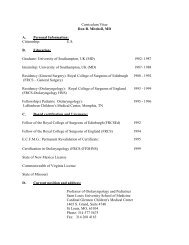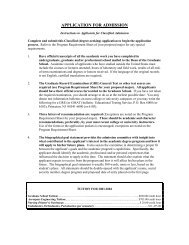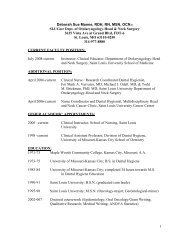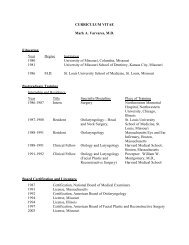Living Image 3.1
Living Image 3.1
Living Image 3.1
Create successful ePaper yourself
Turn your PDF publications into a flip-book with our unique Google optimized e-Paper software.
A. IVIS Acquisition Control Panel<br />
Table A.1 IVIS acquisition control panel<br />
Item Description<br />
F/stop Sets the size of the camera lens aperture.The aperture size controls the amount of light detected and the<br />
depth of field. A larger f/stop number corresponds to a smaller aperture size and results in lower sensitivity<br />
because less light is collected for the image. However, a smaller aperture usually results in better image<br />
sharpness and depth of field.<br />
A photographic image is taken with a small aperture (f/8 or f/16) to produce the sharpest image and a<br />
luminescent image is taken with a large aperture (f/1) to maximize sensitivity. For more details on f/stop, see<br />
Appendix C, page 191.<br />
Excitation Filter A drop-down list of fluorescence excitation filters. For fluorescent imaging, choose the appropriate filter for<br />
your application (GFP, DsRed, Cy5.5, or ICG). For bioluminescent imaging, Block is selected by default. If<br />
you select Open, no filter is present. For systems equipped with spectral imaging capability, choose the<br />
appropriate emission filter for your application (see Chapter 7, page 107).<br />
Note: The excitation filter selection automatically sets the emission filter position.<br />
Emission Filter A drop-down list of fluorescence emission filters located in front of the CCD lens. The emission filter wheel<br />
is equipped with filters for fluorescence or spectral imaging applications. The number of filter positions (6 to<br />
24) depends on the system. For bioluminescent imaging, the Open position (no filter) is automatically<br />
selected by default.<br />
Photograph Choose this option to automatically acquire a photographic image. The illumination lights at the top of the<br />
imaging chamber are on during a photographic image so that the system can acquire a black and white<br />
photograph of the sample(s).<br />
Note: You can adjust the appearance of the photographic image using the Bright and Gamma controls (see<br />
Photo Adjustment, page 53).<br />
Structure Choose this option to take a structured light image (an image of parallel laser lines scanned across the<br />
subject) when you click Acquire. The structured light image is used to reconstruct the surface topography<br />
of the subject which is an input to the Diffuse Luminescence Imaging Tomography (DLIT) algorithm that<br />
computes the 3D location and brightness of luminescent sources.<br />
When this option is chosen, the f/stop and exposure time are automatically set to defaults for the structured<br />
light image (f/8 and 0.2 sec, respectively). The spatial resolution of the computed surface depends on the<br />
line spacing of the structured light lines. The line spacing and binning are automatically set to the optimal<br />
values determined by the FOV (stage position) and are not user-modifiable.<br />
Overlay If this option is chosen, the system automatically acquires a photographic image followed by a luminescent<br />
image, then coregisters the two images.<br />
Lights Turns on the lights located at the top of the imaging chamber.<br />
Alignment Grid<br />
Auto If this option is chosen, the software automatically sets the exposure time to produce a good photographic<br />
image.<br />
Fluor Lamp<br />
Level<br />
178<br />
Sets the illumination intensity level of the excitation lamp used in fluorescent imaging (Off, Low, High, and<br />
Inspect). The Low setting is approximately 18% of the High setting. Inspect turns on the QTH illumination<br />
lamp so that you can manually inspect the excitation lamp.<br />
Note: Make sure that the filters of interest are selected in the filter drop-down lists before you select Inspect.<br />
The Inspect operation automatically positions the selected filters in the system before turning on the lamp.<br />
Subsequent changes to the filter popup menus will have no effect until another Inspect operation is<br />
performed.<br />
Field of View Sets the size of the stage area to be imaged by adjusting the position of the stage and lens. The FOV is the<br />
width of the square area (cm) to be imaged. A smaller FOV gives a higher sensitivity measurement, so it is<br />
best to set the FOV no larger than necessary to accommodate the subject or area of interest. The FOV also<br />
affects the depth of field (range in which the subject is in focus). A smaller FOV results in a narrower depth<br />
of field. Select the FOV by choosing a setting from the drop-down list. For more details on the calibrated<br />
FOV positions A-E, see Table A.3, page 180.<br />
Service Click to move the stage to a position for cleaning.<br />
Load Click to move the stage from the cleaning position back to the home position.




